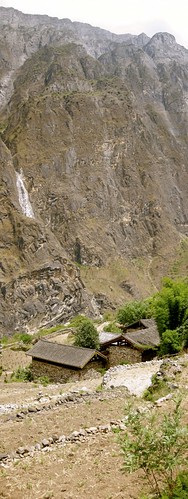Tiger Leaping Gorge
mabroda May 17th, 2009
Very early Saturday morning we left Kunming and our incredibly gracious hosts at Yunnan Agricultural University and headed west into the mountains. We landed in Lijiang airport and drove 3 hours to the Tiger Leaping Gorge. Of course we first have to comment on the food….
Culinary Travels
The meat of the valley was pork. Our guide described it as “nature-raised” pork. We were even offered a piglet to buy on our hike. In light of this, our culinary feature for the day was the pork “pissa” featured above. While not appetizing in appearance, the pissa was surprisingly tasty with a crust like that found in baozi (steamed buns).
The Gorge
The Tiger Leaping Gorge, on the Yangtze River, is one of the deepest in the world, 3900 meters from top to bottom. It is also a possible site for a new dam — one of many on the Yangtze. As our Naxi guide said, the people need electricity but it could destroy the beautiful nature. So in the knowledge that this landscape may soon be irrevocably changed, your intrepid Wooster faculty trekked the middle gorge to see what it was all about.
As the photos show, it was stunning. Beyond that, it appeared to be a successful match of ecotourism with cultural diversity. The local people (about whom David will say more below) continued their traditional farming unfazed by the hikers striding across their property. In an impressive display of entrepreneurship, they set up mini-markets along the way and also took it upon themselves to maintain the middle gorge trail (the government only maintains the upper gorge). They posted signs requesting donations for such activities as maintaining the wire railing, which we appreciated, and constructing the “sky bridge” ladder leading up from the gorge. The photo of David does not indicate how tall and scary that ladder was! We would have felt more impressed with ourselves if we hadn’t been passed by several 80-year-old men — Susan
People of the Valley
After two days in the noise and congestion of Kunming, where cranes and new construction projects greeted us at every turn, it was exciting to spend a day in a village of about 60 families that were sandwiched between the two ridges on either side of the gorge. The villagers in the pictures above are mostly Han Chinese and their livelihoods come from a combination of small-scale farming (corn, beans, etc. with clever irrigation systems rigged from the small streams and waterfalls cascading from the ridges), raising livestock (pigs and goats are sold at market, though every household seemed to have a dog or two and several chickens), and manning the trail toll booths (where they also sold fruit and drinks to weary hikers). The 80-year old man pictured above appeared from his small plot to give us the thumbs up sign as we passed by. Judging from the quality of the houses and the availability of electricity (though firewood is still used by many families for cooking), the villagers here have clearly benefited from tourism and don’t (at least yet) have a jaded view of the hordes of Chinese tourists that frequent the first rapids and the more adventurous ones who cross their farms as they trek further into the gorge. More on some of the ethnic minorities we have encountered in our next post!-David












Gorgeous pictures of the Gorge! It looks like you are having nice weather. I am enjoying the descriptions of your voyage, and I think bringing back a piglet as a souvenir would have been great!
I use a case study on dams along the Yangtze river in my Geology of Natural Hazards Course. As it turns out, the dams trap a lot of sediment and are starving the coastline, causing increased rates of shoreline retreat. We also look at how dams affect the natural response of streams to flooding, and how it impacts the people living in the floodplains. I would love it if one of you could speak to my students about all of your experiences.